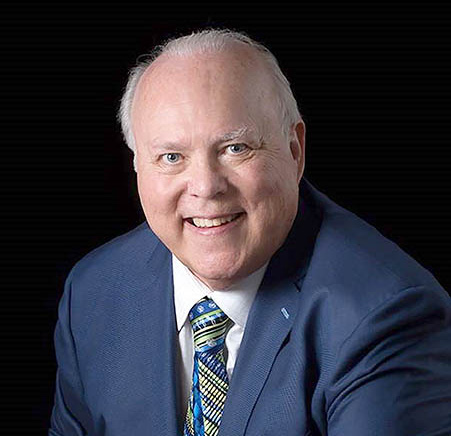View Articles By Category
- All
- Aquatics
- Awards
- Biking
- Camping
- Conservation & Environment
- COPE/Climbing
- Cub Scouting
- Fishing
- National Jamboree
- NCAP
- Outdoor Ethics/Leave No Trace
- Properties
- Range & Target Activities
- Safety
- Shooting Sports
- Sponsored Content

Camping
For those looking to add an exceptional program feature to their summer camp in 2025, take a look at the International Camp Staff Program (ICSP)! The aim of the program is to bring American scouts into contact with Scouts and Scouters from across the globe. Scouts can learn first-hand from international camp staffers about their nation’s Scouting program, their culture, and their customs. For many, this could be a Scout’s first chance to meet someone from another country, creating a summer camp experience they will remember forever.
The great service rendered by the international camp counselors is that they bring to camp the flavor of international Scouting and give significance to the world brotherhood ideal. Many young Scouts do not realize that Scouting is a worldwide program with over 50 million members in over 170 countries.
A great article on the World Organization of the Scout Movement (WOSM) website (https://www.scout.org/news/3-benefits-international-friendship) says having friends from different parts of the world can change our Scout’s lives. International connections and friendships can help Scouts in their personal development and fulfilment. They will learn to appreciate commonalities and differences, expand their perspectives, develop new skills, and maybe even enjoy unique travel experiences according to the article.
Three big benefits of having international friends are gaining a global vision, improving communication skills and feeling at home around the world. Scouting is about helping our future leaders be prepared for their futures.
Through the ICSP, participating Scouts are likely to learn about a new culture, traditions, habits, foods, language, ideas and more. Scouts will laugh as they overcome communication barriers and learn that a smile is the universal language.
The International Camp Staff Program is approved, certified and continually reviewed by Scouting America. Many will remember that previously this program was a function of the International Department. With the restructuring of Scouting America, the ICSP is now a function of Scouting America’s International Committee however, the goals, purposes and objectives of the program remain the same. What was once an entirely in-house program, now requires some specialized services by an external visa vendor, arranged through the ICSP team.
Councils are billed $520 by the visa vendor, but not until they have selected an international camp staff participant and notified the ICSP Team. Local councils should have prospective international staff members participate in a Zoom interview and sign a staff agreement just like US staff members.
Want more information? Please submit any questions, concerns or suggestions you might have through the interest form at https://bit.ly/ICSPCouncils2025.

Camping
As we announced at the National Outdoor Conference last fall, we have been working to update the Summer Camp Staff Training Guide and we are thrilled to announce this crucial update is now complete!
Staff training is critical to our ability to operate safe, quality camps and this resource is meant to help you in the process. If you’re unsure where to start in crafting your staff training plan, this will provide you with a solid foundation to build upon.
Let’s talk about how you might use it:
- NCAP Standard SQ-402? Check, Check, and Check!: You know that standard about having 28 hours of staff training for a long-term camp staff? The guide has over 20 hours of training material for you to use. There are also a few sample staff week schedules in the appendix to help you in planning the order and how to use the modules.
- New Material: From emergency procedures to staff culture, to effective teaching, the guide will share with you some ways to train your staff to be effective. The guide uses the EDGE method of teaching, and each module follows this plan. Ideally you will model the EDGE teaching method for camp through staff training. New modules about Mental Emotional and Social Health and “Making a Great Staff Member” are just a couple of the new modules we have included. One module even includes an ice cream social at the end!
- Tailor-Made Training Plans: Every camp does things a bit different right? The modules, while placed in the guide in a specific order, have some flexibility for you to move them around to meet your camp needs. Build a training schedule that makes sense for your specific camp’s needs.
- Streamline Your Staff Training Planning: Leverage the guide to plan your first 20 hours of staff training and then add in your own camp specific trainings to meet the needs of your specific camps and the other required training hours. Using the sample staff training schedules include in the guide gives you plenty of time for camp set up as well.
- A BIG THANK YOU: A huge shoutout to the volunteers and professionals who worked to put this guide together for us. Camp directors and program directors from across the country were a part of the planning and execution of the guide. Your hard work hasn’t gone unnoticed, and we’re beyond grateful for everything you’ve done.
We’ve already sent out download links to all our current resident (long-term) camp and program directors. And for those attending National Camping School in 2024, keep an eye out because you’ll have one in the materials you are provided with during your training.
We hope you will use this tool in your planning to train the best camp staff around. Let us know if you have any suggestions for improvements and we will keep working to help you train quality staff for your camp.
Camping
If there is one thing with which every Scout I talk to these days can agree, it is this—just how much we are all looking forward to getting back to camp this summer. After two years of spending too much time indoors and away from friends, the 2022 camping season calls to us with promises of adventure, fun, personal growth, and friends—both old and new.
With so many Scouts counting down the days to their summer camp adventure, I want to encourage each of us to ask, “Is your favorite camp ready to provide a mountaintop experience to the girls and women who will attend?”
Consider this: We go to the places we are invited, but we return to the places where we feel welcome. In too many instances, we have invited the girls and women in our community to join us in Scouting programs, but we haven’t done all the necessary work to make them feel welcome — to ensure that they will want to keep coming back.
Jack Welch, former CEO of General Electric, said, “Deal with the world as it is, not how you’d like it to be.” How does this relate to summer camp? It begins with getting truthful about what the readiness level of your camp REALLY is. We don’t solve anything by simply saying, “let’s just build single-gender bathrooms.” We must take a hard and honest look at where we are, or aren’t, regarding our camp structure, and consider where we need to be. Yes, I do understand cost is a factor but there are still ways to make improvements.
Start by pausing and asking what is working well and what is not? How can your camp work to make things better, to be more inclusive and welcoming to all who come and spend time on your properties and in your campsites?
So, let’s get practical and tactical! Here are my 12 tips to make 2022 the best camp experience that our Scouts have ever had.
Awesome Camp Tip #1: Words Matter. Let’s not differentiate between boys and girls; instead let’s just call them Scouts.
Awesome Camp Tip #2: Sell feminine hygiene products in your trading post.
Awesome Camp Tip #3: Put trash cans with liners in every bathroom stall. This is both welcoming and sanitary.
Awesome Camp Tip #4: Mark the gender of every bathroom, including gender-neutral facilities.
Although we could call these first four tips the “small things matter” section; in fact, they matter a lot. Why? Because attending to the small things makes the girls and the women in your camp feel welcome. If a female can’t properly dispose of a feminine product, or purchase one if she is in need, I can tell you from personal experience, she is not going to feel welcome.
Awesome Camp Tip # 5: Avoid terms such as “Smother mother” and “helicopter mom. At your camp, are adult females encouraged to attend along with their youth, or “to cut the umbilical cord?” When you hear these terms being used by staff, by Scouts, or by adult leaders, take a moment and explain why speaking about women in camp this way perpetuates a stereotype that says women complicate the camp environment, rather than contribute to it.
Awesome Camp Tip # 5: Re-evaluate your application process for staff.
Are leadership experiences that youth gain outside of Scouting valued, or do you base your assessment purely on Scout experience? There is a long list of experiences that prepare a young person to be a great camp staffer. Quality camp programs have a lot to do with a focus on customer service, and youth get that experience in various ways.
Awesome Camp Tip # 6: Take the feedback forms you get each week seriously.
We’ve all read a feedback form that is overly harsh and unfair. Those are easy to disregard, but does your camp have a practice of looking honestly at the feedback you receive, or are you rationalizing why you can disregard what you’re reading? Are you willing to pivot and adjust throughout your camp season to ensure that one person’s challenging experience this week does not become someone else’s challenging experience next week?
Awesome Camp Tip #7: Set behavior expectations prior to arrival for all units.
Share behavior expectations with unit leaders as part of pre-camp orientation information. Emphasize the expectations in staff training and review with campers during orientation each week. Provide a reporting example and make it clear that reporting of unacceptable behavior is mandatory. Everyone in camp is responsible for ensuring a healthy and welcoming environment for all campers! It is NOT our job to decide whether a situation merits being reported; it is our job to report issues and allow camp leadership to assess the situation and decide what action to take.
Awesome Camp Tip #8: Make sure all units know what to expect each day of camp, prior to arriving. Don’t assume legacy knowledge from any unit or leader. Offer a pre-camp Q&A session.
Awesome Camp Tip #9: Swimwear — stop using the word MODEST.
From the National BSA Aquatics Subcommittee; “We recommend that swimwear should be comfortable, functional, and appropriate for the specific aquatic activity. As always, we remind everyone that Scouting’s Barriers to Abuse state, ‘Appropriate attire is required for all activities’. Policies should reflect the BSA’s statement and commitment to diversity, equity, and inclusion.”
Awesome Camp Tip #10: Establish an Upstander culture in your camp.
Create a see-something, say-something expectation among staff, campers, and adult leaders. Make public statements to of expectations. Ensure it’s clear to everyone in camp that certain behaviors are not appropriate and will be addressed quickly if they occur.
I ran a camp for youth and adults with disabilities for 10 years. Trust me when I tell you that everyone knows when something has “happened” in camp. Often the details are not appropriate to share with everyone, but your transparency in sharing that there’s been an incident and it is being handled, and then using this as a teachable moment to remind everyone about rules and expectations, is an example of your leadership!
Awesome Camp Tip #11: Stop making exceptions or excuses for bad behavior by anyone in camp, especially when it is displayed by adults.
The notion that we don’t want to make Scouter X upset because he or she has given 25 years or even 50 to Scouting is not acceptable. . We need to treat everyone equitably.
Awesome Camp Tip #12: It takes all of us working together to impact change. Find and focus on your allies and let them help influence others
Find the people at your camp, and in your council, who want to make Scouting an equal and fair space for all youth to thrive. Align yourselves with them. Ask for their help. Get to know the other women in your council. Introduce yourself to other women in camp. Work together. Find the leaders already in place in your Scouting community who want to help you and let them! Often those leaders already in place are men. They may be men who are equally passionate about our camps being a safe and welcoming place for girls and women to enjoy Scouting. Look for them. They can teach you a lot, and you can teach them too!
I’ll leave you with this vision for the future of Scouting:
Let’s make sure every Scout camp in our country embraces the opportunity to provide a welcoming place for all girls and women, so that they can contribute to a thriving Scouting movement. All of us can help improve Scouting for each young person. Please share with us via outdoorprograms@scouting.org ways that you helped provide an even more welcoming environment for your campers.
Now let’s go camping, see you on the Scouting Trail!
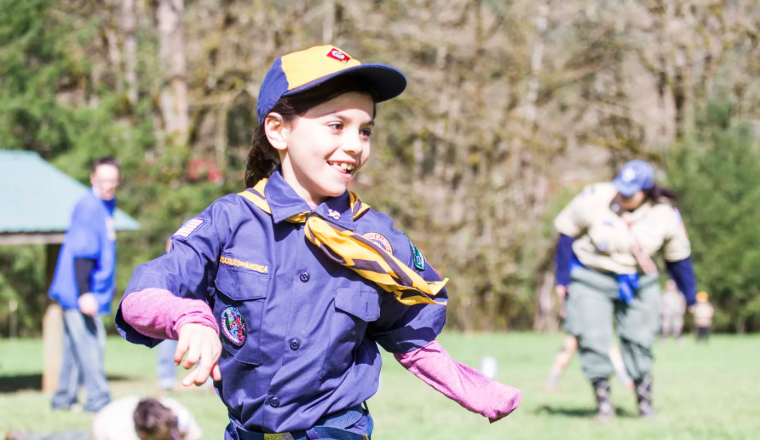
CampingCub Scouting
As the weather warms and nature begins to bloom, spring offers a perfect opportunity for local councils to provide engaging outdoor programming that excites Cub Scouts and encourages participation. For camp leadership, crafting innovative spring activities can bridge the gap between winter hibernation and the summer season, ensuring Cub Scouts remain connected to the Scouting program while building anticipation for day camp or long-term camp. Here are some creative ideas for districts and councils to implement:
1. Spring Nature Exploration Events
Organize guided nature hikes or wildlife exploration days at camp properties. With a focus on discovery, Cub Scouts can learn about plants, animals, and ecosystems coming alive in the spring. Adding themed scavenger hunts or badge-related activities can create an educational and entertaining experience while familiarizing Scouts with your camp properties.
2. Outdoor Skills Workshops
Host day or weekend events focused on age-appropriate outdoor skills. Activities like knot-tying, shelter building, fishing, and basic first aid provide hands-on experiences while preparing Cub Scouts for future adventures. Incorporating skills into fun challenges or games ensures that learning remains engaging and enjoyable.
3. Themed Adventure Days
Plan themed adventure days to ignite imaginations. For example:
- Pirate Adventures: Include treasure hunts, map reading, and water-related activities.
- Wild West Days: Teach archery, introduce simple outdoor cooking, and offer horseback riding or stick pony races.
- Superhero Training Camp: Incorporate obstacle courses, teamwork challenges, and problem-solving activities.
Themes like these not only attract participation but also give Cub Scouts a taste of summer camp excitement.
4. Spring Service Projects
Encourage Cub Scouts to give back to their communities with spring service projects. Clean-up days at local parks, planting flowers or trees, and repairing trails teach valuable lessons in stewardship and community involvement. Hosting these events at campgrounds can also help prepare your property for summer use while connecting Scouts to the space.
5. Cub Scout Camp Preview Days
A spring open house or camp preview day can familiarize parents with your camp’s amenities and programming. Offer short rotations of camp activities like BB guns, archery, and crafts to provide a taste of what summer camp will bring. This not only builds excitement for day camp or long-term camp but also increases early registrations.
6. Family Picnic and Campout Events
Invite Cub Scouts and their families to a spring picnic or overnight campout. Pair the event with simple games, a nature walk, or a campfire program to showcase your facilities and the fun awaiting in Scouting. These events help build relationships with families and create lasting memories.
7. Outdoor STEM Programs
Integrate STEM (Science, Technology, Engineering, and Math) into outdoor activities. Build weather stations, experiment with water filtration, or explore solar energy through hands-on projects. Combining STEM with the outdoors encourages curiosity and keeps Scouts engaged in learning outside the classroom.
8. Springtime Cub Olympics
Host a Cub Scout Olympics event featuring fun, age-appropriate challenges like sack races, relay races, tug-of-war, and water bucket relays. Add a recognition element with medals or ribbons to celebrate participation and achievements.
Enhancing Spring Programs for Camp Leadership
To make these programs successful, camp leadership can focus on:
- Marketing: Use newsletters, social media, and school outreach to promote events. Highlight the fun and educational benefits of participation.
- Partnerships: Collaborate with local organizations, nature centers, or experts to enrich programming with unique resources and knowledge (PD-109).
- Volunteer Engagement: Recruit dedicated volunteers or older Scouts to assist with running activities, ensuring smooth operations and mentorship opportunities.
- Feedback Loops: Gather feedback after events to continuously refine and improve programming for future seasons.
By offering creative and engaging spring outdoor programs, local councils can keep Cub Scouts excited about Scouting, strengthen family connections, and build momentum for summer day camp or long-term camp. The key lies in fostering a love of the outdoors while ensuring activities are fun, meaningful, and memorable.
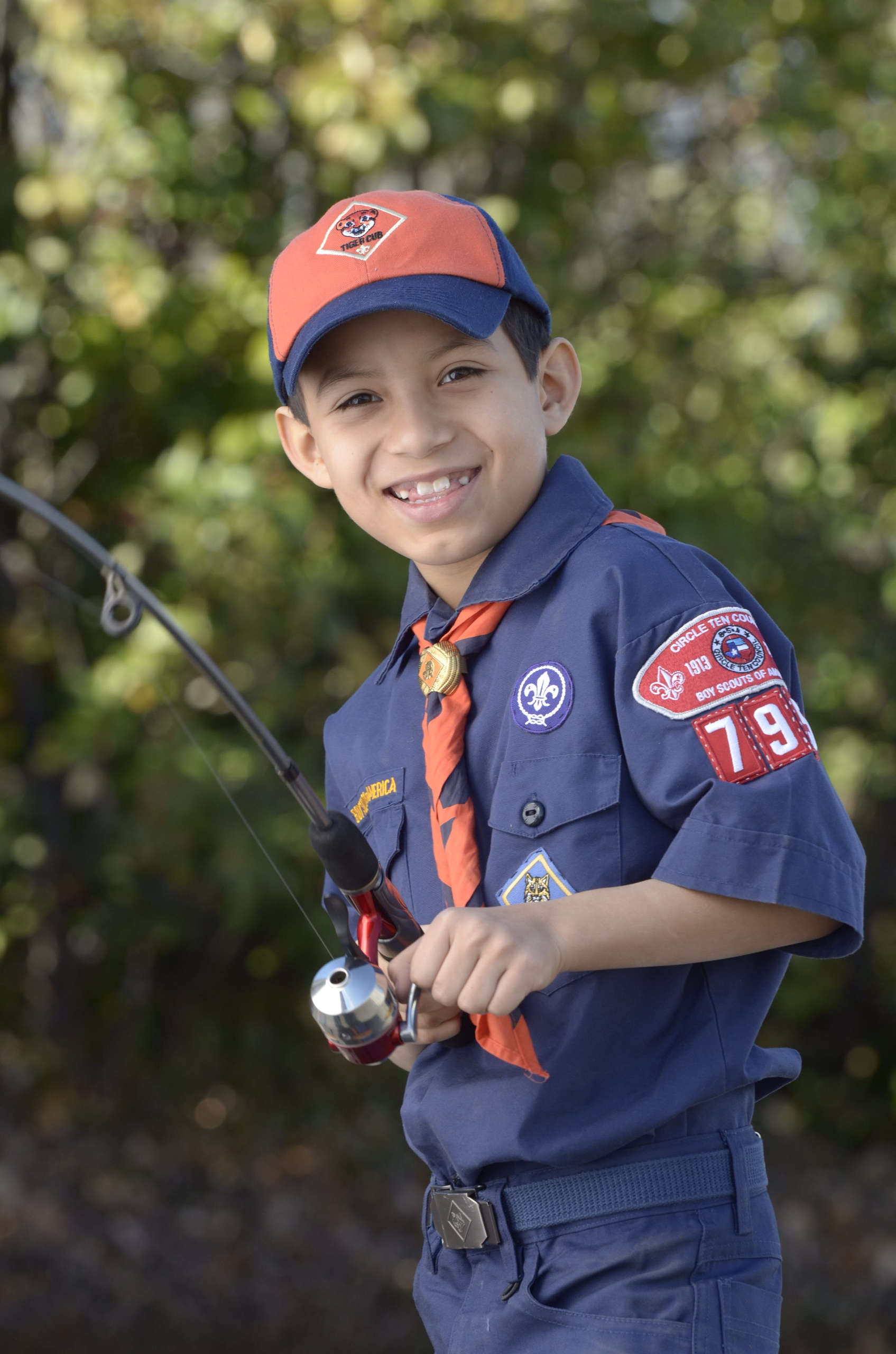
Fishing
You bet it has! The National Fishing Sub Committee has responded to this by some hard work by our members to adapt to the “new normal”.
A revision to the Fishing Merit Badge Counselor’s Guide and the Fly-Fishing Merit Badge Counselor’s Guide have been made. Check them out at: https://filestore.scouting.org/filestore/Outdoor%20Program/pdf/FishingCounselorGuide.kc.pdf
https://filestore.scouting.org/filestore/Outdoor%20Program/pdf/Fly-FishingCounselorGuide.kc.pdf
With virtual meetings being used due to the Covid-19 pandemic, we are in development of a course on virtual meetings and how to have them. We know many of our Certified Angling Instructors would make good use of these.
We are currently building the online portion of Certified Angling Instructor (CAI) Course. We realize there is a hands-on element to fishing so at this point we think about a third of this cornerstone course for fishing can be done virtually.
The next online development challenge will be the merit badges. We think much of the material can be taught online but there may be elements that will need equipment or instruction that cannot be virtual. We are hoping to have a viable online curriculum by the end of summer on both the CAI Course and Fishing Merit Badge.
Now, let’s talk about being safe in the “new normal”. If we are to go outside, we need to practice social distancing. Hey, what about fishing? Social distancing is easy while fishing, especially when fishing from shore.
You do not need a fancy boat, piles of fishing rods or really any fancy equipment to have fun fishing. At most local lakes, all you need is a stick or cane pole, fishing line, hooks, a bobber and worms to have fun. Who can remember being 8 to 15 years old and catching bluegill all day until you couldn’t see the bobber anymore because it was dark? These are some of fond memories we can help build.
Our commitment to youth has always been to create memories for them. Don’t you have the same idea? Help our youth to get that cane pole, bobber, hooks and worms to go fishing. By doing this, we can create a memory for them forever.
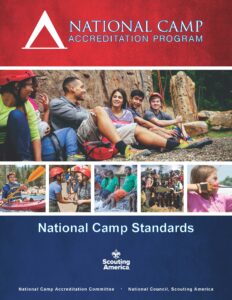
NCAP
As of January 1, 2025, the updated National Camp Accreditation Program (NCAP) standards will be in effect. Councils must review these updates to ensure compliance and maintain safe, high-quality programs. The latest standards can be downloaded from the NCAP website at https://stg.scouting.org/NCAP or directly via this link.
How to Identify Changes in the Standards
There are two ways to locate updates to the NCAP standards:
- Table of Contents Annotations: The table of contents notes changes to standards for 2024 and 2025.
- Circular #22: This document provides a detailed breakdown of changes, standard by standard. Access Circular #22 here.
Key Changes Councils Should Note
NCAP Standard PD-112:
Councils must adopt and implement a plan to review every activity at all types of camps at least once every three years. This review focuses on identifying and addressing any significant incidents to improve participant safety.
NCAP Standard SQ-406:
Following a change in American Red Cross policy, individuals completing the National Camping School’s Aquatics Director Section will no longer be certified to train lifeguards. Camps must:
- Ensure aquatics staff receive proper training elsewhere, or
- Have someone in the council become an American Red Cross Lifeguard Instructor to train staff as required.
As of January 1st, 2025 the BSA Lifeguard program is no longer being taught. Once a person’s current certification expires, it cannot be renewed.
NCAP Standard SQ-412:
Clarifications have been made regarding First-Year Camper Directors. These directors must demonstrate specific knowledge to receive a council waiver if they have not attended National Camping School to become Outdoor Program Directors.
NCAP Standard FA-717:
A quick reminder, as of January 1, 2024, all beds with mattress foundations more than 30 inches above the floor must have guardrails to prevent falls. This requirement applies to all beds in buildings, Adirondacks, tents, and other sleeping areas.
Additional Notes and Deadlines
Several other changes to the standards have been made. Councils and camp staff are strongly encouraged to thoroughly review the updated standards to ensure compliance. Failure to meet these standards during an assessment could result in the temporary closure of non-compliant areas.
May 15 Deadline:
All summer programs must submit their Declaration of Readiness to their assessment team leader by May 15 for review.
Need Help?
For more information about the updates or assistance with the standards, contact your local NCAP Zone Coordinator or email ncap@scouting.org. Staying informed and prepared will ensure that your camps provide safe, enriching experiences for all participants.
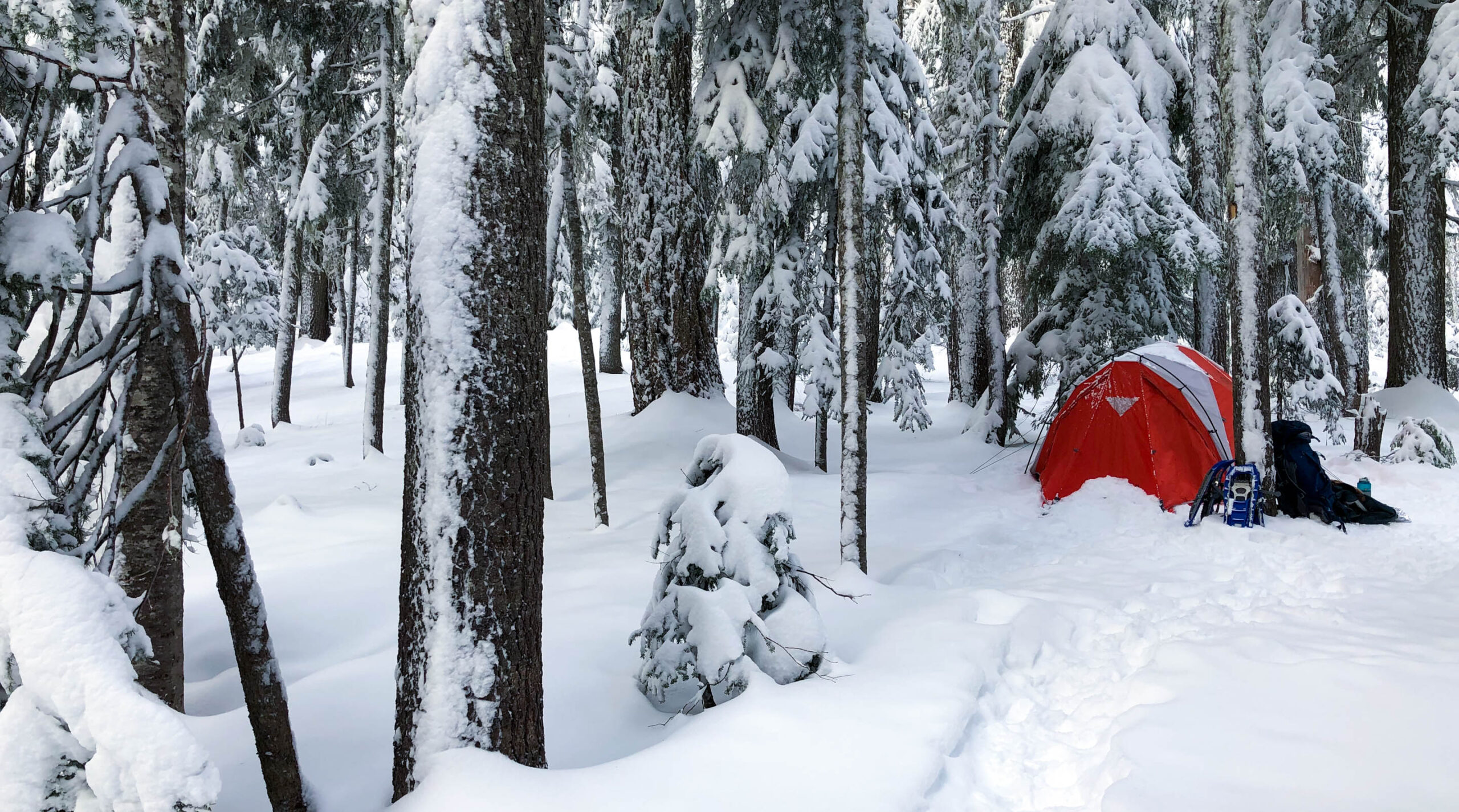
Camping
Winter camping with a Scout unit of 20 to 40 Scouts can be an incredible adventure. However, the potential for environmental impact increases significantly with larger groups, especially in fragile winter ecosystems. Practicing Leave No Trace (LNT) principles is essential to ensure the natural world remains undisturbed. Here are some tips to help you plan and execute a responsible winter camping trip:
Planning Ahead
Preparation is the foundation of Leave No Trace camping. Winter environments can be harsh, so careful planning is critical for both safety and minimizing environmental impact.
- Research the Area: Select a campsite that can accommodate your group without causing excessive impact. Check local regulations and guidelines.
- Know the Conditions: Monitor weather forecasts and ensure everyone packs clothing and gear suitable for freezing temperatures, snow, and ice.
- Divide and Conquer: Break the group into smaller patrols to minimize the impact on any one area.
Choosing a Campsite
Winter landscapes are delicate, with snow-covered vegetation and fragile ecosystems beneath. Proper site selection is crucial to prevent long-term damage.
- Stick to Trails: Travel on established trails or deep snow to avoid damaging underlying vegetation.
- Choose Durable Campsites: Camp on snow, ice, or bare ground, and stay at least 200 feet from water sources to protect riparian zones.
- Avoid Sensitive Areas: Stay away from meadows, young trees, and wildlife habitats. Rotate high-traffic areas within your camp to prevent snow compaction and damage.
Managing Waste
Improper waste disposal can harm wildlife and pollute water sources. Responsible waste management is a core LNT principle.
- Pack It In, Pack It Out: Carry out all trash, including food scraps, in sealable bags. Don’t leave anything behind.
- Dishwater Disposal: Strain dishwater to remove food particles, scatter the water away from camp, and pack out any solid waste.
Using Fire Responsibly
Campfires can scar the environment and deplete natural resources. Limit their use and focus on sustainable practices.
- Use Stoves: Opt for camp stoves over fires for cooking and warmth whenever possible.
- Fire Rings: If fires are permitted, use established fire rings or build a mound fire on durable surfaces like snow.
- Limit Firewood Use: Gather only small, dead wood from the ground and completely extinguish fires before leaving.
Respecting Other Visitors
The wilderness is a shared space. Show respect to others to ensure everyone has a positive outdoor experience.
- Yield on Trails: Step aside for smaller groups or individuals and avoid creating deep ruts with snowshoes or skis.
- Leave It Better: Sweep the area for litter or damage, even if it wasn’t caused by your group.
Special Considerations for Large Groups
Larger groups naturally have a greater impact, so additional precautions are necessary to reduce their footprint.
- Educate Participants: Before and during the trip, remind Scouts of Leave No Trace principles and encourage adherence.
- Share Gear: Minimize duplication by using communal tents, cooking equipment, and other shared items.
By diligently applying Leave No Trace principles, Scout groups can enjoy the unique challenges and beauty of winter camping while preserving the wilderness for future generations.

Camping
This will be a continuing series of articles on various aspects of the properties we own, lease, care for, and look to make better. As we all know, the program of Scouting is valuable to the growth of youth in this country and around the world. Where we deliver that program needs to convey that value and the coming articles are intended to assist us all in making that conveyance to our current users, as well as all our future users and their families.
In the last edition of Let’s Do Better, we discussed forests and the trees that make up those wonderful places folks in this organization like to spend quality time in! And while we talked about replanting and harvesting the various species that grow within those forests we didn’t talk very much about protecting them. Sure, we could talk about cutting break lines in case of fire. Installing roads through the forests so there’s access should fire occur (these can be minimal and combined with a break line is ideal). Maintaining a forest stand is a whole lot more than just cutting out the dead wood! But, how else can we protect this precious asset? Property Insurance.
Little thought was given to how complex and involved the topic of insurance was going to be. Like many, we know it’s a good idea to ‘carry’ insurance. Yes, we do pay for it. Why? No, not why do we pay for it. Why do we ‘carry’ it? Why do we pursue having insurance in the first place?
“Insurance is a means of protection from financial loss.”
That’s a line from the Wikipedia article on insurance much of this month’s article is based upon. A means of protection from financial loss.
The idea of insurance if you will, is quite old. In fact, similar “transferring or distributing risk” was practiced in the 3rd and 2nd millennia BC. Traders in that day spread their goods across several transport vehicles with the expectation that one or more of the transports would not make the journey. The vehicles at the time were vessels on the rivers and streams by which traders moved their goods to a market. A few factors could possibly overturn a vessel and the cargo was lost. In this way, the trader insured at least some of his goods made it to market, if not all.
“The law of general average constitutes the fundamental principle that underlies all insurance.”
Tablets from the dynasty of Nerva-Antonine in the ruins of the Temple of Antinous in Aegyptus (Egypt) in approximately 133 AD during the reign of Hadrian of the Roman Empire prescribed rules and membership dues of a burial society. In essence, early burial insurance. Other concepts of insurance have been found in 3rd century BC Hindu scriptures. In ancient Greece they developed marine loans in order to ensure their cargo was delivered in order to receive payment in full. The idea of a separate contract to insure something was invented in the 14th century in Genoa. Life insurance to cover a person was not created until 1583, in London. Property insurance can be traced to the Great Fire of London in 1666 which consumed more than 13,000 homes. In fact, in the 1680s the first fire insurance company was established at the back of the Royal Exchange, the very place the first life insurance policy was written. As London grew as a center for trade the demand for marine insurance increased. Edward Lloyd saw the opportunity, opened a “coffee house” whereby shippers would meet with folks who were willing to underwrite a shipment thus creating Lloyd’s of London as an insurance market.
So, even though insurance has been around for centuries, most of the varying types of insurance we know today have really been developed since the late 18th century. Even today new types of policies are created in response to world events.
But the question remains, why? Insurance is basically a pooling of funds from many, to pay for losses incurred by a few. Most of us have car insurance. We pay monthly premiums, the pool, and file a claim when we encounter an accident. If the claim meets the terms of the policy, we’re paying premiums on, the insurance company pulls from that pool of funds we’ve been contributing to along with many other drivers and pays us, or the company repairing the damage, what’s required to fix, or “make whole again” what we possess. Then we can drive our newly repaired vehicle down the road again. Easy enough, right? The line, “If the claim meets…” is loaded with a lot of subjects to be dissected a bit to better understand the purpose of this month’s article for Let’s Do Better when looking at our property insurance!
You all know that numerous insurance companies exist. We do have a choice when it comes to the purchase of insurance in whatever form we’re looking to acquire. And to say there’s a choice is a big understatement! Insurance companies exist because they make money. In 2020, insurance companies in the US of A had $2.5 trillion in direct premiums written. Yes, that’s trillion with a ’T’! That’s a bunch of billions, and a whole lot more millions. You all also know that when you file a claim the expectation is one of apprehension as to the effort it’s going to take to get something out of the insurance company to help you pay for your loss. But yet, they have trillions!
Also remember you entered into this contract, the policy, with the insurance company. You pay premiums for the coverage which should be stipulated in that contract. The insurance company when you file a claim has to examine the terms of your contract with them, see that it meets the terms of paying you for your loss, and then distributing funds. This all takes time as you are not the only person insured. As all of the contracts, policies, are not the same clarifying the loss and how it meets the terms of it may be more involved than a simple “I was in an accident. I need to repair my car. Please pay me so I can repair my car and get on with my life” scenario. Why is that?
Again, you are one of many paying into a pool of funds by which claims are drawn from.
Given some of the catastrophic events that have occurred, the insurance companies cannot just pay every claim as each needs to be vetted and shown to be accurate and true. Some insurance companies have gone out of business as they exceeded the funds to pay claims on. Not a good scenario for you in that one! So, again, why mention this?
You need to pay attention to several items when purchasing property insurance. Plain and simple.
Are you purchasing the correct type of insurance contract (policy) for what it is your
insuring? What’s the value of the item your insuring? The value today and if it’s an item that appreciates, the value in the coming years. This is what you are protecting! This is the potential loss item. What are the parameters that you and the insurance company agree to for your potential loss? This would be the terms under which the insurance company will reimburse you for the loss of the item insured.
And that is where a lot of folks get confused and where the unhappy circumstances of trying to get that reimbursement come from. You simply don’t understand the terms you agreed to! And you wouldn’t be alone in that! More than likely, you wanted a low premium. But, from the insurance company side you’re contributing to the pool a little, but when you make a claim, the expectation is the company will pay you fully for your loss. From their side you haven’t contributed enough to the pool to be compensated that way and if you looked at your contract that’s probably what it says. That’s where all the data the companies collect nowadays is crunched over and over again so they know practically to the penny what an accident like you’ve experienced should cost them. That’s how they figured your contract to protect the item you’re insuring and the terms of that protection.
So, next time you’re in the market for insurance, what are you going to look at? What questions will you ask and how closely are you going to examine the contract/policy? Yes, you want protection, but you want it fairly and to where it will adequately cover your loss.
Several councils in the organization have experienced devastating fires on their properties in recent years. They’ve lost buildings. They’ve lost the forests which grew on the property. They’ve lost the business side of the operation which has affected their financial position. Hopefully, we’ve all learned that some were better insured than others and have made appropriate adjustments to what our property insurance contracts cover. Pay attention to the terms of those contracts and what can be expected in the “to make whole again” process. Are you paying for simple coverage, or are you paying for replacement cost coverage? With the cost of materials and labor rising the way they are today, pay that extra so you can get your property back up and running more completely! Be sure to obtain the contract that best protects you and what your insuring. Insurance is not necessarily all that complex, but in many ways it helps all of us manage our property assets so we are minimally exposed to a substantial loss. And that protects us all!
See you next issue!
Dave Cornell
Architect
Mar ’22
The Outdoor Programs / Properties Team is ready to assist and guide in any respect to making the program of Scouting the best youth program! Reach out to any member of the team and we’ll endeavor to provide quality answers to any issue you may have and/or facing. We look forward to working together to make the program the best ever!
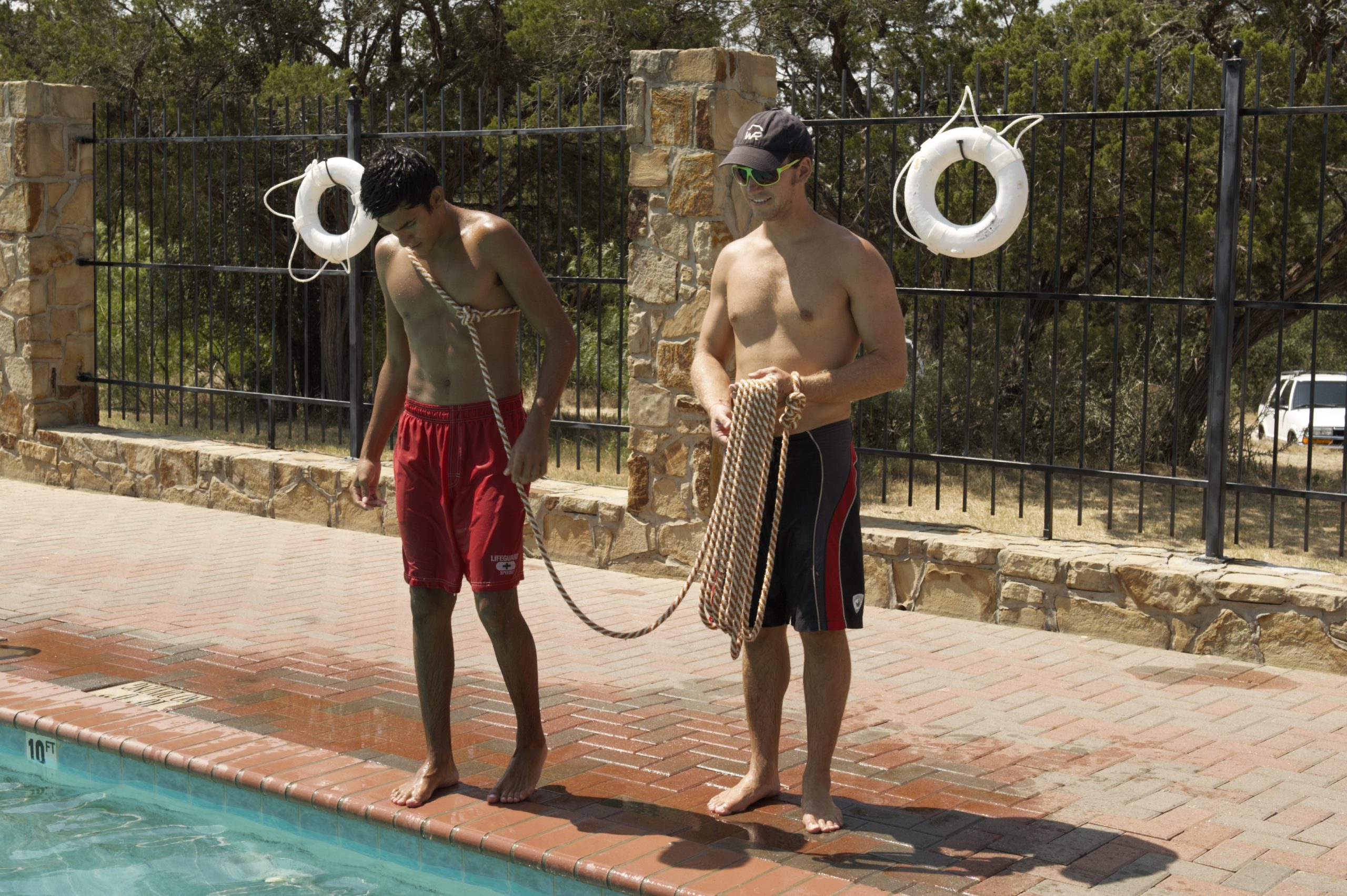
Aquatics
Industry practices for facility lifeguards require the venue, such as a council camp, confirm and document lifeguard competency specific to that location. Simply checking that a lifeguard has a valid certification is not sufficient to meet current standards of care. Those expectations are reflected in NCAP standard SQ-406:
C. Aquatics area staff. The following requirements apply to aquatics area staff:
- All aquatics lifeguarding staff are tested for competency by the aquatics director before assuming lifeguarding or instructional duties. The aquatics director shall keep written documentation of staff and the areas and activities for which they are qualified. Staff in training may not work unsupervised until approved in written documentation by the aquatic’s director. The required skill competencies for lifeguarding include:
- All lifeguards can reach the bottom at the deepest part of the swimming area.
- All lifeguards can reach the furthest extent of their assigned zones within 20 seconds.
- All lifeguards can currently perform water rescue skills (possession of a lifeguard training certificate is not enough; each aquatics director must check that they can still perform to standards).
- All lifeguards can currently perform BLS and first-aid skills (possession of a card is not enough; each aquatics director must check that they can still perform to standards).
- All lifeguards must be trained to execute written emergency action plans specific to local camp swimming areas and activities.
- All lifeguards respond to bloodborne pathogen incidents according to the OSHA-mandated exposure control plan.
To meet those requirements, lifeguard assessment and preservice training, at a minimum, should include:
- Rescue of an active victim, at or near the surface in deep water. This rescue to include victim recognition, emergency action plan (EAP) activation, entry, approach, rescue, and assisting the victim from the water. Each skill must be performed consecutively, not individually.
- Rescue of a passive victim, at or below the surface in deep water. This rescue to include victim recognition, EAP activation, entry, approach, rescue, victim extraction, and after care, including CPR, following camp procedures. Although not specifically required by SQ-406 C, it is appropriate to record the time from EAP activation to beginning of CPR and repeat the exercise if that time exceeds 90 seconds, as specified in BSA Lifeguard requirements 16 and17. Each lifeguard must be evaluated on both the rescue and the ability to perform CPR. However, the same person need not do both in the same scenario. A team response is preferred. Anyone demonstrating CPR must use proper personal protective equipment (PPE).
- Scenario based rescues are encouraged, with each lifeguard having to react to the situation rather than everyone doing the same rescue one after the other. If victims are placed at the furthest extent of the largest zones, and submerged at the area’s maximum depth, then SQ-406 standards a. and b. may be assessed at the same time as rescue skills. Otherwise those should be tested individually.
- Spinal injury management, including in-line stabilization in both shallow and deep water and spinal backboard extraction, is also a critical lifeguard exercise. Since a team approach is needed, it should be part of pre-service training for the entire safety team following procedures in a written EAP.
- For camps where swimming is conducted in murky water, the safety team must also receive pre-service training in the camp’s written EAP for a lost bather. Ideally, the safety team should recover a submerged dummy, or item of similar size and weight to that of an actual person, placed in an unknown position.
- The safety team should review the camp’s exposure control plan for blood borne pathogens and practice using both PPE and clean-up materials as specified in that plan.
Lifeguard assessment and preservice training exercises are similar to those conducted as part of a lifeguard training course. The skill sheets in the current American Red Cross Lifeguarding Manual, which is the text for BSA Lifeguard, provide the performance standards. The BSA Lifeguard Instructor Manual, supplemented by the American Red Cross Lifeguarding Instructor’s Manual, provides evaluation guidance. Therefore, lifeguard assessments and preservice training should be conducted by a current BSA Aquatics Instructor, BSA Lifeguard Instructor or American Red Cross Lifeguard Instructor.
The facility lifeguard skill assessment and preservice training differs from a lifeguard training course in that the exercises are conducted at the facility where the lifeguard serves. The exercises involve the facility safety team, facility rescue equipment and follow that venue’s written EAPs. Therefore, camp lifeguard assessments and preservice training should be conducted at Camp.
Note that SQ-401 C also requires documentation. The camp aquatics director should have a copy of each lifeguard’s training certificate. Assessments and preservice training exercises should be recorded on a check-off form noting the skill, each

NCAP
Camps are designed to be a place for fun, adventure, and personal growth. Unfortunately it is also a time when mental health concerns can arise. As camp leaders, unit leaders, and staff, it is essential to be equipped with the knowledge and resources to support campers and staff who may be struggling. We are not mental health professionals, but we can all watch and see if challenges arise – not just during summer camp but throughout the entire year.
Why is this important? Mental issues are serious and can affect individuals of all ages, including children and teenagers. Suicide is the second leading cause of death among individuals aged 10-24. September is Suicide Prevention Month, a critical time to focus on raising awareness and providing support for those at risk. As adult volunteers in Scouting, it is essential to be equipped with the right resources and knowledge to support the well-being of the Scouts. One key resource is the National Suicide Prevention Lifeline, available 24/7 at 1-800-273-8255. This lifeline offers free and confidential support, prevention and crisis resources for individuals in distress, and best practices for those providing assistance. Additionally, the Crisis Text Line is available 24/7 by texting “HELLO” to 741741, connecting individuals with trained crisis counselors.
So, what can I do to help you might ask?
- Post resource numbers like the ones listed above around your camp properties, even during events this fall and winter.
- Encourage older Scouts BSA, Sea Scouts and Venturing members to view the Personal Safety Awareness Video focused on Suicide Prevention. You can access the video and discussion guide here. You could even host a camp staff meeting and use this as the topic.
- We all need to make certain that all camp staff are trained in recognizing the warning signs. Staff need to know how to respond to a camper in crisis, and the importance of seeking help from mental health professionals. Make certain that your camp has a plan (NCAP Recommended Practice 551), even as part of short-term camps this fall and winter.
- Promote campers to the importance of self-care practices, such as mindfulness, relaxation techniques, and healthy coping mechanisms. Encourage physical activity, time outdoors, and social connections as ways to improve mental well-being. Not only promote this, but also lead by example. Staff and unit leaders need to set an example by taking care of themselves.
- Encourage camp staff and volunteers to take “Mental Health First Aid” or other similar training before summer camp next year. The “off-season” is a great time to take these important trainings.
Remember, we are not mental health experts and we cannot solve every issue, but showing someone that we care about them can make a difference.

Aquatics
As Scouts we strive to remain active outdoors year round and for many of us that means be out in cool to very cold air and potentially cold water temperatures. Whether you are hiking along a creek or lake or paddling on the water if accidently fall in cold water your chances for survival are good if you understand how your body responses to cold water and how you can best support yourself until help arrives.
Dr. Gordon Giesbrecht of the University of Manitoba has performed extensive research on cold water exposure and has the following recommendations.
First, let’s consider water temperatures. Water temperatures for swimming can be simply classified as “Pleasant” (68F – 77F); “Ok, once used to it” (59F – 68F); “Brisk, nippy” (50F-59F); “Darn cold” (41F – 50F); and “FREEZING” (32F – 41F, remember). In “Pleasant” conditions it is fun and easy to with swim without any additional cold protection (like a wet suit). With “Ok” conditions you will feel a bit cool at first but get used to it. When the water is “Brisk” it will feel very cool when you first get in but with experience you can swim for a while before hypothermia is a serious risk. At “Darn cold” water temperature it is painful to get in and only short swims of a few minutes can be tolerated before significant risks occur. And, as you might expect, at “Freezing” it is extremely painful to be in the water and the time in the water should be limited to only a minute or two. Also, remember, in general, water temperatures do not change as quickly as air temperature during the course of the day and once water gets cold, say due to cold nights, the water is unlikely to warm up much in the day. So, it could be that if you fall into water during cold seasons, it is possible for the water to be cooler than the air temperature during the day. Another thing to keep in mind is that fresh water freezes at 32F and salt water at a colder temperature. So, although salt water may not be frozen the water temperature could actually colder than “freezing” (32F).
Dr. Gordon Giesbrecht of the University of Manitoba has performed extensive research on cold water exposure in humans and has the following recommendation for what to do if you find yourself in cold water.
The 1 Minute; 10 Minute; 1 Hour Principle.
So, let’s explore more about what happens when you accidently immerse yourself in cold water. First, the good news, you can survive a fairly long time in cold water if you DON’T PANIC, stay calm and follow these steps to help yourself.
Cold Shock Response. In cold water the immediate response of your body is to uncontrollably gasp for air and hyperventilate (think about the time when your big brother doused you with a bucket of ice water). So, first, DON’T PANIC and keep your head above the water. This this is critical because you can easily inhale (aspirate) water into your lungs which is extremely dangerous. Keep reminding yourself to stay calm, keep your head above water and control your breathing. Adjust your breathing so that it is steady and evenly paced. Once you have steadied your breathing and you have relaxed as best you can you can then consider what actions to take next.
After 1 minute in very cold water Cold Incapacitation begins to impact your body functions. This is due to the effect of cold water on your nerves and muscles. It becomes painful to move your muscles and your ability to control your muscles becomes increasing worse. This hampers your body’s ability to move or hold on to things. Over the next 10 to 20 minutes under these conditions the symptoms will continue to a point where the use of your limbs is basically useless. Therefore, you must quickly plan on what to do and then carry out your plan prior to complete loss of useful muscle function. The primary goal now is to quickly (within 10 minutes or so) get as much of your body out of the water as possible. If you were in a boat, Don’t Panic, control your breathing and get to the boat and try to get in or crawl on top of an overturned boat. If you fell into a lake or river from the bank or a bridge, the same applies, Don’t Panic, control your breathing and find something to climb on or find a spot to get out of water within 10 minutes.
The longer you are in the water the greater risk of developing hypothermia. If you cannot self-rescue by getting your body out of the water you then must begin to prepare for the possibility of hypothermia. Hypothermia, is the decrease of your body’s core temperature. Many factors contribute to hypothermia and how fast it can happen. This includes the water temperature, how much of the body in immersed in the water and your own body’s size and condition. In cold water (water below 68F), most people will become hypothermic in 1 – 2 hours. So, if you haven’t been able to get yourself out of the water you need to think back to your Scout aquatics training (Swimming merit badge) to the H.E.L.P. position in cold water (Heat, Escape, Lessening, Position). That can make a big difference in slowing down the onset of hypothermia. This can only be effectively done if you have your lifejacket on so that’s another great reason to always wear your lifejacket when in a boat! If you are with one or more buddies the best thing to do is to get into a HUDDLE position where you crowd together to conserve body heat. This action also slows the onset of hypothermia.
Once you become hypothermic you will eventually lose consciousness. At that point you have around another hour or so until you may experience cardiac arrest. In all cases, when out on a hike or on the water you should always be certain your leaders must know where you are and when you are expected back. If you are late returning, they should begin to search for you to provide help.
So, remember, if you find yourself accidently immersed in cold water remember the 1 minute, 10 minute and 1 hour principle and: 1) Don’t Panic; 2) Keep you head above the water and try to control your breathing; 3) Make a plan for getting as much of your body as of the water as quickly as possible; 4) If you cannot get out of the water within 10 or so minutes assume the HELP position or if with buddies, then Huddle-UP to delay the onset of hypothermia. Always wear your lifejacket when in a boat and also always be sure your leaders know your plans when going on a hike or boating so if you are late returning, they can find you and give your help.
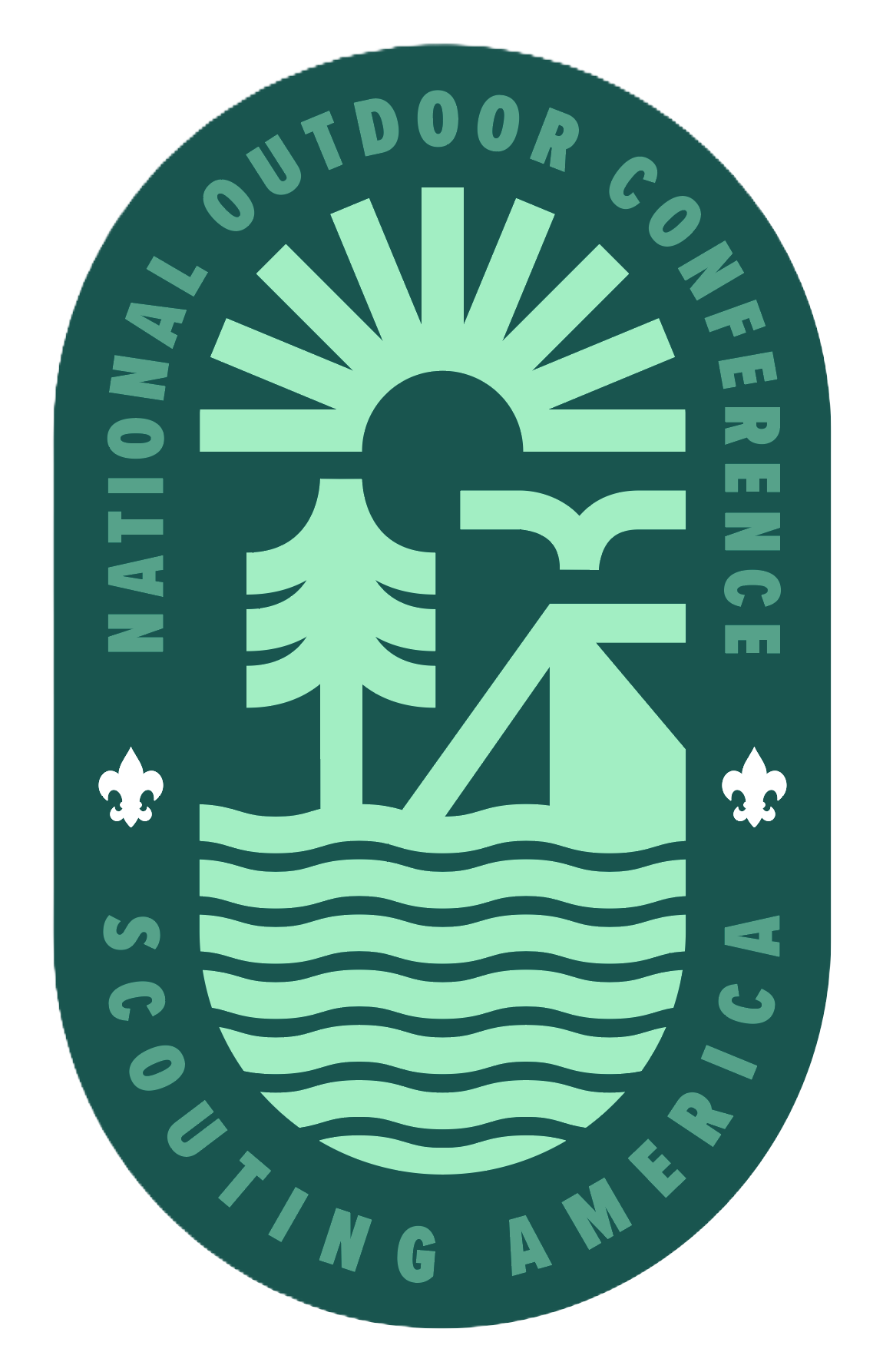
Camping
Join us in the heart of the rugged Southwest at Philmont for the 2025 National Outdoor Conference—the ultimate gathering for Scouters and outdoor enthusiasts! Whether you’re looking to level up your skills, get inspired by top speakers, or simply connect with like-minded adventurers, this biennial event is the place to be.
Where: 📍 Philmont Training Center, Cimarron, NM
When: 📅 September 17-21, 2025
🌟 Conference Highlights:
- Dynamic workshops and hands-on training to elevate your outdoor programs
- Inspiring keynotes from leaders in the outdoor industry
- Networking opportunities with Scouters and outdoor pros from across the country
- A firsthand look at the latest in gear, gadgets, and innovations
Don’t miss this chance to discover new ideas, sharpen your skills, and share in the excitement of the great outdoors with fellow Scouters. Stay tuned for updates on registration, class offerings, lodging, and more!
Be sure to sign up on the 2025 National Outdoor Conference website to receive email alerts—let the countdown to adventure begin!
Email blast!
Email blast!



